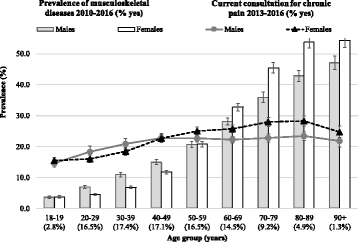Epidemiology of arthritis, chronic back pain, gout, osteoporosis, spondyloarthropathies and rheumatoid arthritis among 1.5 million patients in Australian general practice: NPS MedicineWise MedicineInsight dataset
- PMID: 29347932
- PMCID: PMC5774097
- DOI: 10.1186/s12891-018-1941-x
Epidemiology of arthritis, chronic back pain, gout, osteoporosis, spondyloarthropathies and rheumatoid arthritis among 1.5 million patients in Australian general practice: NPS MedicineWise MedicineInsight dataset
Abstract
Background: Previous estimates for the prevalence of musculoskeletal conditions (MSK) and chronic pain in Australia have been based on self-report. We aimed to determine the prevalence and distribution of arthritis, chronic back pain, gout, osteoporosis, spondyloarthropathies and rheumatoid arthritis and current consultations for chronic pain among adults attending Australian general practice, and describe their distribution according to sociodemographic characteristics and presence of co-morbidities.
Methods: We investigated 1,501,267 active adult patients (57.6% females; 22.5% ≥65y) evaluated between 2013 and 2016 and included in the MedicineInsight database (a National Prescribing Service MedicineWise program), a large general practice data program that extracts longitudinal de-identified electronic medical record data from 'active' patients in over 550 practices. Three main groups of outcomes were investigated: 1) "prevalence" of arthritis, chronic back pain, gout, osteoporosis, spondyloarthropathies, and/or rheumatoid arthritis between 2000 and 2016; 2) "current" diagnosis/encounter for the same conditions occurring between 2013 and 2016, and; 3) "current" consultations for chronic pain of any type occurring between 2013 and 2016.
Results: The combined "prevalence" of the investigated MSK (diagnosis between 2000 and 2016) among adults attending Australian general practice was 16.8% (95%CI 15.9;17.7) with 21.3% (95%CI 20.2;22.4) of the sample consulting for chronic pain between 2013 and 2016. The investigated MSK with the highest "prevalence" were arthritis (9.5%) and chronic back pain (6.7%). Patients with some of these MSK attended general practices more frequently than those without these conditions (median 2.0 and 1.0 contacts/year, respectively). The "prevalence" of the investigated MSK and "current" consultations for chronic pain increased with age, especially in women, but chronic pain remained stable at 22% for males aged > 40 years. The investigated MSK and chronic pain were more frequent among those in lower socioeconomic groups, veterans, Aboriginal and Torrent Strait Islanders, current and ex-smokers, and patients with chronic obstructive pulmonary disease or heart failure.
Conclusions: The investigated MSK are more frequent among lower socioeconomic groups and the elderly. Based on information collected from adults attending Australian general practices, MedicineInsight provided similar estimates to those obtained from population-based studies, with the advantage of being based on medical diagnosis and including a national sample.
Keywords: Arthritis; Back pain; Epidemiology; Musculoskeletal; Pain, chronic; Population health.
Conflict of interest statement
Ethics approval and consent to participate
MediciniInsight was approved by the Royal Australian College of General Practitioners (RACGP) National Research and Evaluation Ethics Committee on 10 January 2013. The program considers three different consent to participate levels before data collection. First, the general practice owner is provided with a comprehensive Practice Kit that includes information for them to make an informed decision to participate in the program. Second, GPs are informed by the general practice owner about the practice’s participation in the program, and are given the opportunity to consent to receiving individual tailored reports. Finally, patients are made aware of the program through promotional material that is displayed within the waiting room of all participating practices, so they have the opportunity of verbally informing the practice about their choice not to participate. Verbal consent was obtained considering that MedicineInsight does not collect patients’ identifiable information such as name, date of birth and address, thus representing a low safety risk for the participants. Additionally, all MedicineInsight data requests are approved by an independent Data Governance Committee that includes GPs, Statisticians and consumer representatives. Finally, the Human Research Ethics Committee of the University of Adelaide exempted this study of an ethical review, as it used existing and non-identifiable data.
Consent for publication
Not applicable.
Competing interests
There authors declare that they have no competing interests.
Publisher’s Note
Springer Nature remains neutral with regard to jurisdictional claims in published maps and institutional affiliations.
Figures



References
-
- Briggs AM, Cross MJ, Hoy DG, Sanchez-Riera L, Blyth FM, Woolf AD, March L. Musculoskeletal health conditions represent a global threat to healthy aging: a report for the 2015 World Health Organization world report on ageing and health. Gerontologist. 2016(56 Suppl 2):S243–55. - PubMed
-
- Global Burden of Disease Study C Global, regional, and national incidence, prevalence, and years lived with disability for 301 acute and chronic diseases and injuries in 188 countries, 1990-2013: a systematic analysis for the global burden of disease study 2013. Lancet. 2015;386(9995):743–800. doi: 10.1016/S0140-6736(15)60692-4. - DOI - PMC - PubMed
-
- Cross M, Smith E, Hoy D, Nolte S, Ackerman I, Fransen M, Bridgett L, Williams S, Guillemin F, Hill CL, et al. The global burden of hip and knee osteoarthritis: estimates from the global burden of disease 2010 study. Ann Rheum Dis. 2014;73(7):1323–1330. doi: 10.1136/annrheumdis-2013-204763. - DOI - PubMed
Publication types
MeSH terms
LinkOut - more resources
Full Text Sources
Other Literature Sources
Medical

